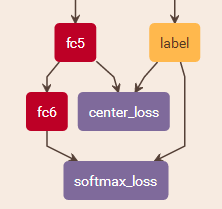论文阅读笔记:Center Loss: A Discriminative Feature Learning Approach for Deep Face Recognition
本文主要包含如下内容:
本篇论文针对图像分类添加一个新损失 center loss, 进一步缩小类内距离,获得更高的性能. ECCV2016
主要思想
center loss 主要在softmax的基础上,通过对训练集的每一个类别在特征空间分别维护一个类中心,在训练过程中,增加样本经过网络映射后在特征空间与类中心的距离约束,从而兼顾了类内聚合与类间分离.
网络结构
center loss 作为训练阶段的辅助loss,只需要在特征输出层中引入即可:

这里损失被更改为 softmax 和 center loss,其中,center loss作为辅助损失约束前一层特征的内类距离,softmax loss 约束类间距离.在损失函数的定义中:权重W代表最后一层的权重.

center loss:cyi表示第yi个类别的特征中心,xi表示全连接层之前的特征。其中,m表示mini-batch的大小。因此这个公式就是希望一个batch中的每个样本的feature离feature 的中心的距离的平方和要越小越好,也就是类内距离要越小越好。

示意图为算法的大致流程:首先更新权重 W,其权值更新只与 softmax 损失有关;随后,更新类中心 C,类中心的计算为当前类中心的值与类中心的平均偏移量之和,这里有一个超参数a(为了防止mini-bath类中的扰动);最后,正常情况下更新网络的权重
实验结果
只采用损失 softmax loss 结果:

softmax loss + center loss 结果:主要变化在于类内距离 intra-class
代码实现
源文件主要由四个部分组成:caffe.proto/center_loss_layer.cpp/center_loss_layer.cu/center_loss_layer.hpp. 只需要导入到对应的caffe中编译即可,这里我们就再进行相应的讲解.
接下来,我们看看源码center_loss_layer.hpp:
#ifndef CAFFE_CENTER_LOSS_LAYER_HPP_
#define CAFFE_CENTER_LOSS_LAYER_HPP_
#include <vector>
#include "caffe/blob.hpp"
#include "caffe/layer.hpp"
#include "caffe/proto/caffe.pb.h"
#include "caffe/layers/loss_layer.hpp"
namespace caffe {
template <typename Dtype>
class CenterLossLayer : public LossLayer<Dtype> {
public:
explicit CenterLossLayer(const LayerParameter& param)
: LossLayer<Dtype>(param) {}
virtual void LayerSetUp(const vector<Blob<Dtype>*>& bottom,
const vector<Blob<Dtype>*>& top);
virtual void Reshape(const vector<Blob<Dtype>*>& bottom,
const vector<Blob<Dtype>*>& top);
virtual inline const char* type() const { return "CenterLoss"; }
virtual inline int ExactNumBottomBlobs() const { return 2; }
virtual inline int ExactNumTopBlobs() const { return -1; }
protected:
virtual void Forward_cpu(const vector<Blob<Dtype>*>& bottom,
const vector<Blob<Dtype>*>& top);
virtual void Forward_gpu(const vector<Blob<Dtype>*>& bottom,
const vector<Blob<Dtype>*>& top);
virtual void Backward_cpu(const vector<Blob<Dtype>*>& top,
const vector<bool>& propagate_down, const vector<Blob<Dtype>*>& bottom);
virtual void Backward_gpu(const vector<Blob<Dtype>*>& top,
const vector<bool>& propagate_down, const vector<Blob<Dtype>*>& bottom);
int M_; // mini_batch
int K_; // 特征输入的长度
int N_; // 输出神经元的个数
Blob<Dtype> distance_; // 存放前向传播距离差
Blob<Dtype> variation_sum_; // 记录样本距离对应类中心的距离
};
} // namespace caffe
#endif // CAFFE_CENTER_LOSS_LAYER_HPP_接下来,我们看看源码center_loss_layer.cpp:
#include <vector>
#include "caffe/filler.hpp"
#include "caffe/layers/center_loss_layer.hpp"
#include "caffe/util/math_functions.hpp"
namespace caffe {
template <typename Dtype>
void CenterLossLayer<Dtype>::LayerSetUp(const vector<Blob<Dtype>*>& bottom,
const vector<Blob<Dtype>*>& top) {
const int num_output = this->layer_param_.center_loss_param().num_output();
N_ = num_output; // 输出神经元的个数
const int axis = bottom[0]->CanonicalAxisIndex( // 将特征C*H*W拉直为一个特征
this->layer_param_.center_loss_param().axis());
// Dimensions starting from "axis" are "flattened" into a single
// length K_ vector. For example, if bottom[0]'s shape is (N, C, H, W),
// and axis == 1, N inner products with dimension CHW are performed.
K_ = bottom[0]->count(axis); // 特征输入的长度
// Check if we need to set up the weights
if (this->blobs_.size() > 0) {
LOG(INFO) << "Skipping parameter initialization";
} else {
this->blobs_.resize(1);
// Intialize the weight
vector<int> center_shape(2);
center_shape[0] = N_; // 类似输出维度
center_shape[1] = K_; // 类似输入维度
this->blobs_[0].reset(new Blob<Dtype>(center_shape)); // 尺寸设置为center_shape的大小
// fill the weights
shared_ptr<Filler<Dtype> > center_filler(GetFiller<Dtype>(
this->layer_param_.center_loss_param().center_filler()));
center_filler->Fill(this->blobs_[0].get());
} // parameter initialization
this->param_propagate_down_.resize(this->blobs_.size(), true);
}
template <typename Dtype>
void CenterLossLayer<Dtype>::Reshape(const vector<Blob<Dtype>*>& bottom,
const vector<Blob<Dtype>*>& top) {
CHECK_EQ(bottom[1]->channels(), 1);
CHECK_EQ(bottom[1]->height(), 1);
CHECK_EQ(bottom[1]->width(), 1);
M_ = bottom[0]->num(); // mini_batch
// The top shape will be the bottom shape with the flattened axes dropped,
// and replaced by a single axis with dimension num_output (N_).
LossLayer<Dtype>::Reshape(bottom, top);
distance_.ReshapeLike(*bottom[0]);
variation_sum_.ReshapeLike(*this->blobs_[0]);
}
template <typename Dtype>
void CenterLossLayer<Dtype>::Forward_cpu(const vector<Blob<Dtype>*>& bottom,
const vector<Blob<Dtype>*>& top) {
const Dtype* bottom_data = bottom[0]->cpu_data(); // 输入倒数第二层的feature
const Dtype* label = bottom[1]->cpu_data(); // 输入label
const Dtype* center = this->blobs_[0]->cpu_data(); // 指向类中心的指针
Dtype* distance_data = distance_.mutable_cpu_data(); // 记录样本距离对应类中心的距离
// the i-th distance_data
for (int i = 0; i < M_; i++) {
const int label_value = static_cast<int>(label[i]); // 第i个样本对应的label标签
// D(i,:) = X(i,:) - C(y(i),:)
caffe_sub(K_, bottom_data + i * K_, center + label_value * K_, distance_data + i * K_); // 计算样本到对应类中心的距离,存放在distance_中
}
Dtype dot = caffe_cpu_dot(M_ * K_, distance_.cpu_data(), distance_.cpu_data()); // L2范数,定义loss
Dtype loss = dot / M_ / Dtype(2);
top[0]->mutable_cpu_data()[0] = loss; // 存放loss
}
template <typename Dtype>
void CenterLossLayer<Dtype>::Backward_cpu(const vector<Blob<Dtype>*>& top,
const vector<bool>& propagate_down,
const vector<Blob<Dtype>*>& bottom) {
// Gradient with respect to centers
if (this->param_propagate_down_[0]) {
const Dtype* label = bottom[1]->cpu_data(); // 输入label
Dtype* center_diff = this->blobs_[0]->mutable_cpu_diff(); // 存取center的更新值
Dtype* variation_sum_data = variation_sum_.mutable_cpu_data();
const Dtype* distance_data = distance_.cpu_data();
// \sum_{y_i==j}
caffe_set(N_ * K_, (Dtype)0., variation_sum_.mutable_cpu_data()); // variation_sum_初始化
for (int n = 0; n < N_; n++) {
int count = 0;
for (int m = 0; m < M_; m++) {
const int label_value = static_cast<int>(label[m]); // 第m个样本对应的label标签
if (label_value == n) {
count++;
caffe_sub(K_, variation_sum_data + n * K_, distance_data + m * K_, variation_sum_data + n * K_); // distance_data为前向传播时存的D(i,:) = X(i,:) - C(y(i),:) // variation_sum_data为每一类的总偏移量
}
}
caffe_axpy(K_, (Dtype)1./(count + (Dtype)1.), variation_sum_data + n * K_, center_diff + n * K_); // 计算类中心的偏移量(对每一类而言),这里记录了this->blobs_[0]->mutable_cpu_diff(),更新后获得新的this->blobs_[0]->cpu_data()
}
}
// Gradient with respect to bottom data
if (propagate_down[0]) {
caffe_copy(M_ * K_, distance_.cpu_data(), bottom[0]->mutable_cpu_diff()); // 返回每一个样本的偏移量(二范数的梯度就是偏移量)
caffe_scal(M_ * K_, top[0]->cpu_diff()[0] / M_, bottom[0]->mutable_cpu_diff()); // l2范数的导数 ,bottom[0]->mutable_cpu_diff()就是D(i,:) = X(i,:) - C(y(i),:)。
}
if (propagate_down[1]) {
LOG(FATAL) << this->type()
<< " Layer cannot backpropagate to label inputs.";
}
}
#ifdef CPU_ONLY
STUB_GPU(CenterLossLayer);
#endif
INSTANTIATE_CLASS(CenterLossLayer);
REGISTER_LAYER_CLASS(CenterLoss);
} // namespace caffe
